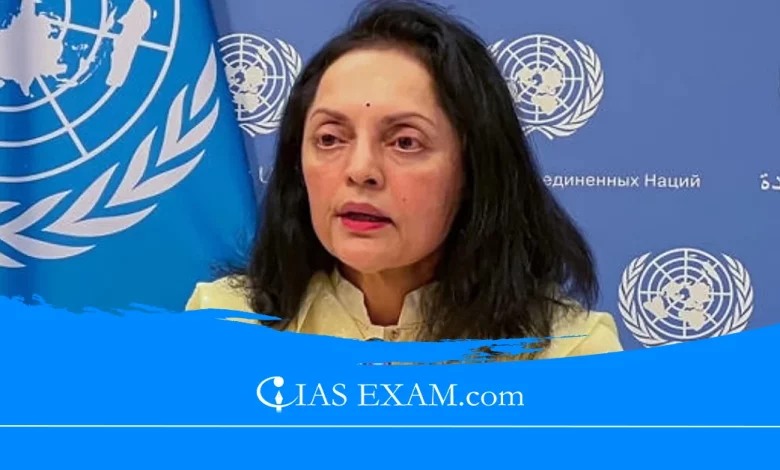Daily Current Affairs for UPSC
G4 model for Security Council reform
Syllabus- International Organisation [GS Paper-2]

Context
India has recently presented a detailed model on behalf of the G4 nations for Security Council reform.
About
- India presented the ‘G4 model’ on behalf of Brazil, Germany, Japan and India for debate, communication and finally negotiations.
- The proposals elicited robust aid from wider UN members.
- New Members: It proposes that the Security Council’s membership increase from the modern-day 15 to 25-26, by adding 6 permanent and 4 or 5 non-permanent members.
- Regional Representation: Among the 6 new permanent members, two each are proposed to be from African states and Asia Pacific states, one from Latin American and Caribbean states; and one from Western European and Other states.
- Flexibility in Veto: The G4 model offered flexibility at the veto, even as the new permanent members would, as a precept, have the same duties and obligations as current permanent members, they shall not workout the veto until a choice on the problem has been taken throughout an assessment.
- Permanent Members aren’t Specified: G4 model does not specify which member states will occupy the new permanent seats.
- This selection can be made by the General Assembly in a democratic and inclusive election.
About the UNSC
- The United Nations Security Council (UNSC) is one of the essential organs of the United Nations, responsible for keeping international peace and security.
- It was hooked up in 1945 as a part of the UN Charter and consists of 15 member states, together with 5 permanent individuals with veto power—China, France, Russia, the UK, and the United States—and 10 non-permanent members elected for 2-year terms through the General Assembly.
- It is established in New York City.
Need for the Reforms in the UNSC
- Current Composition: The cutting-edge composition of the Security Council has below-illustration and un-representation of key regions.
- Inability to Address Conflicts: The current composition of the council has an incapacity to cope with critical conflicts and hold international peace and security.
- Changes in World Order: The world has passed through sea trade for the reason that 1945 and the new realities need to be pondered in the permanent membership.
- Any idea that does not deal with the issue of representation of the Global South, inclusive of Africa, Asia and Latin America, in the permanent class does a grave injustice to the aspirations of growing nations for equality.
- Veto Power: Currently, most effectively the 5 permanent individuals preserve veto powers and via its use have stalled motion in the Council to deal with international challenges and conflicts consisting of in Ukraine and Gaza.
- The remaining 10 countries in the Council are elected to sit down as non-permanent members for 2-year terms and do not have veto powers.
- Legitimacy: The disproportionate strength held with the aid of the 5 permanent members, especially their veto energy, can lead to a notion of unfairness and absence of legitimacy.
Limitations in Introducing the Reforms in UNSC
- Veto Power of Permanent Members: Any reforms to the composition or working strategies of the UNSC require the approval of the 5 permanent members.
- These countries have divergent pastimes and are reluctant to assist adjustments that could reduce their influence in the Council.
- Regional Dynamics: Regional rivalries and geopolitical tensions complicate efforts to reform the Council.
- Complexity of the Reform Process: Amending the UN Charter to enact reforms requires a lengthy and complicated method regarding ratification by a huge variety of member states, making it difficult to enact important reforms.
- Chinese Opposition: China being a permanent member blocks the increase of India turning into a Permanent Member.
Way Ahead
- It is critical that both the permanent and non-permanent membership be representative of the world as it’s miles these days, not the world because it existed within the wake of the Second World War.
- Reforms inside the UNSC are crucial for keeping its relevance, legitimacy, and effectiveness in addressing the complicated security challenges facing the worldwide community in the 21st century.
- However, accomplishing consensus on such reforms among the various UN’s member states remains a hard and ongoing process.
Source: The Hindu
UPSC Mains practice Question
Q.Discuss India’s position in getting closer to permanent membership of UNSC.(250 words)
- India presented the ‘G4 model’ on behalf of Brazil, Germany, Japan and India for debate, communication and finally negotiations.
- Regional Representation: Among the 6 new permanent members, two each are proposed to be from African states and Asia Pacific states, one from Latin American and Caribbean states; and one from Western European and Other states.
- Flexibility in Veto: The G4 model offered flexibility at the veto, even as the new permanent members would, as a precept, have the same duties and obligations as current permanent members, they shall not workout the veto until a choice on the problem has been taken throughout an assessment.
- Permanent Members aren’t Specified: G4 model does not specify which member states will occupy the new permanent seats.





.png)



